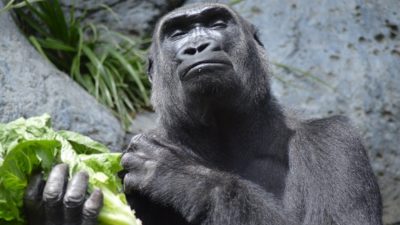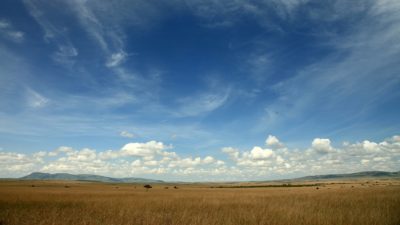Naturally vegan – how evolution shaped us

The most common mistake is someone pointing at their little canine teeth and saying: “What are these for, then?” I seriously doubt they would or could snatch up a rabbit and tear into the flesh with these little things like real carnivores do. A lion’s giant canines can reach up to seven centimetres in length and can rip just about anything apart!
Lions and wolves
We’re very different to carnivorous animals such as lions and wolves – we have short, soft fingernails and small, blunt canine teeth. They, on the other hand, have strong jaws that can only open and shut, sharp teeth and claws that help them to tear off chunks of raw meat and ‘wolf’ them down without the aid of a knife and fork! Their acidic stomachs help them digest flesh quickly and their short intestines allow the rapid expulsion of rotting meat remains.
The diet of wolves, for example, consists mainly meat from large prey such as elks, with nutrient-dense organs eaten first followed by muscle tissue. When carnivores eat saturated fat from meat it does them no harm while we, on the other hand respond very differently. Saturated fat clogs up our arteries and increases our risk of heart disease and stroke.
Rabbits, horses and sheep
Herbivores, such as rabbits, horses and sheep, chew from side-to-side and their saliva contains enzymes that begin the digestive process and they have longer intestines to absorb nutrients. When asked if humans are herbivores, carnivores or omnivores, Dr William C. Roberts, Editor-in-Chief, of The American Journal of Cardiology said: “Although most of us conduct our lives as omnivores, in that we eat flesh as well as vegetables and fruits, human beings have characteristics of herbivores, not carnivores”.
Paleo diet
In the 1980s, US anthropologists Boyd Eaton and Melvin Konner suggested the Palaeolithic or hunter-gatherer diet as a model for modern human nutrition. Proponents reckon the mismatch between the diets of our ancient ancestors and Western-style contemporary diets is to blame for our high levels of obesity, diabetes and heart disease. However, the average life expectancy of our ancient ancestors was extremely low – just 25 years. So, even if they did live on a diet of meat and more meat (they didn’t) they simply didn’t live long enough to develop heart disease! Not a good starting point for modern dietary recommendations.
The theory is flawed on many levels. It assumes that our ancestors ate mostly lean meat and fish but no dairy, some fruit and vegetables but no grains or pulses. However, evidence shows that people in Palaeolithic times ate a much more plant-based diet than this. More than 9,000 remains of edible plants found in a Stone Age site in Israel provide compelling evidence that they enjoyed a varied, plant-based diet, including root vegetables, leafy veg, celery, figs, nuts, seeds and chenopodium seeds, which are similar to quinoa.
Neolithic farmers
Another problem is the assumption that humans did not change from the Palaeolithic era – about 2.6 million years ago – to the start of the agricultural revolution. Genetic evidence shows that not to be so and that we continued to evolve well into the Neolithic era 12,000 years ago when farming rapidly spread across Europe.
Geochemical analysis of grains and pulses from Neolithic sites confirms that like their predecessors, early farmers relied much more heavily on plant protein than previously thought. Relatively recent genetic changes that helped include the increased production of amylase, an enzyme in our saliva that helps us digest the starchy carbohydrates found in bread, rice and other wholegrains. Interestingly, domesticated dogs produce much more amylase than wolves from whom they evolved – not in their saliva but from their pancreases – allowing them, too, to thrive on starch-rich diets.
Adaptions
Another adaptation that favours a plant-based diet includes our ability to build long-chain fatty acids, important for brain development and cognitive function. Neolithic farmers probably ate less of these than their predecessors and evidence shows how we developed enzymes to build these long chain fats from short ones, found widely in nuts and seeds.
Meat did not make us smart
Despite the wealth of evidence that plant-based diets have fuelled our evolution, the meaty myths persist, including the notion that meat somehow made us smart. In the 1990’s, British scientists Leslie Aiello and Peter Wheeler proposed the ‘expensive-tissue hypothesis’ whereby there is a trade-off between the size of the digestive tract and the brain. The brain is considered ‘expensive’ as it requires a lot of energy compared to other parts of the body. The diet can only provide so much energy – so a smaller gut allows a bigger brain.
The theory is that eating meat enabled us to reduce the size of our gut, freeing up energy to increase brain size. But research refutes this, showing it was a combination of factors, including cooking that improved the quality of the diet by making food easier to digest. We also saved energy by walking upright, by growing more slowly and reproducing later and these factors fuelled the growth in our brain size.
We are not suited to eating raw meat or cooked meat, even at moderate levels, as these are linked to a wide range of health problems, including heart disease, diabetes and cancer – in fact, all the modern diseases Paleo pundits suggest meaty diets can protect us against. The research simply doesn’t support the notion that humans are designed to eat meat.
The typical Western diet, packed with meat, dairy and processed food, is linked to a wide range of illnesses and diseases but a Paleo diet is not the answer! All major health bodies recommend reducing meat consumption, not only for your own health but for the planet, too, because livestock farming is having a devastating effect on the environment. A varied vegan diet can meet all your nutritional needs and is the best diet for animals and the planet – and we are designed for it!
Find out more about whether we are meat-eaters or wheat-eaters here.







